It happens that you take a hot bath or shower, steam up, relax - it's time to put yourself in order. You go to the mirror - and it is completely fogged up, and even a towel cannot dry it. Either the smell from a previous visitor or an obsessive air freshener persists in the toilet for a long time. Familiar situations? Connecting an exhaust fan in the bathroom and toilet, a common one or two separate ones, will help to solve such problems.
You should not neglect the quality of ventilation in the bathroom, because this is a matter of not only convenience, but also safety. Over time, mold and mildew, dangerous to human health, start to grow along the bathroom, in the corners and in the seams between the tiles. It is often possible to completely remove them only during major repairs, so the purchase and installation of an exhaust fan pays off with interest, preventing such problems.
In this article, we will tell you how to organize a forced ventilation system in a bathroom, what to look for when buying equipment, how to install and connect everything yourself. Consider connection schemes suitable for different fan models and conditions of use, as well as give some useful tips on ventilation in the bathroom and toilet.
The content of the article:
- Fan selection and starting method
-
Fan wiring diagrams
- Devices with a switch on the case
- Connecting the fan to the lighting
- Connection via switch
- Inclusion of an external sensor in the circuit
- Fan installation procedure
- Common mistakes and additional tips
- Conclusions and useful video on the topic
Fan selection and starting method
There are many exhaust fan models, including for a bathroom. They differ not only in size and appearance. There are a number of characteristics to consider when choosing and purchasing.
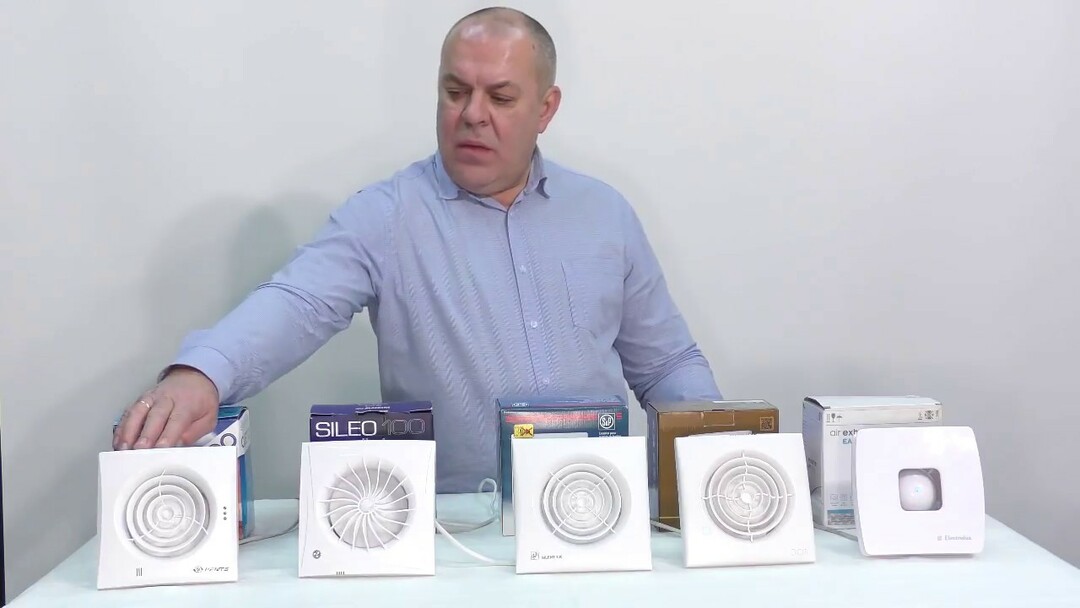
Fans for the bathroom are overhead and duct, with a solid front panel or grill, in different colors and designs
The first thing that determines the connection diagram of the fan for exhausting air from the bathroom is the way to start it.
Depending on the model, there are such options:
- Turning on the fan on the case with a button or a cord - they are the easiest to connect, but every time it is not very convenient to reach under the ceiling.
- Starting with a separate switch or in parallel with lighting. The fan itself also has only 2 wires, but the possible connection diagrams are more complex and varied. Including, with an external timer or hygrometer, motion sensor or door opening.
- Controlled by a built-in timer or hygrometer. Such models are connected with a three-core wire.
- Remote control through the remote control. These models combine the simplicity of connection of the first option and maximum ease of use, but they also cost the most.
Also, not every exhaust fan is suitable for a bathroom. The fact is that this is electrical equipment, and to work in high humidity conditions, the protection class must be at least IP45, which is confirmed in the documents.
In this case, each digit of the marking should be considered separately, that is, IP62 protection is not suitable, since the second digit indicates resistance to moisture, it must be at least 5.
In practice, protection is implemented in the form of isolated connection contacts, a hidden or moisture-resistant control board, and a sealed motor housing.
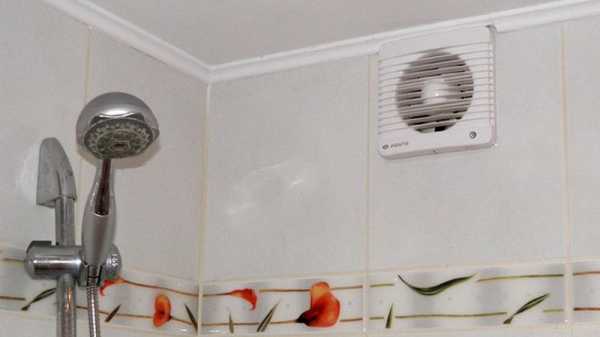
Even fans with high moisture protection characteristics are not recommended to be located so that they can get water
You should also decide on the type of device design. Axial models are cheaper, but more noisy, since the air passes directly through them. Centrifugal fans create vortex currents that push air in a circle - much quieter. In addition, for a private house, you can choose which are installed inside the ventilation duct, and not at the exit from it.
Another critical parameter is fan power and performance. To do this, the volume of the room must be multiplied by 6 - 8, depending on the number of residents. The resulting figure is the minimum required volume of air exchange per hour.
A fan that is too weak will not cope well with its task, it will have to be left on for a long time. Too powerful will not only add strong drafts, but also can provoke a backflow of air from a common ventilation shaft, with all the neighboring smells.
Also pay attention to the fan diameter. If it does not match the diameter of the existing ventilation hole, additional pipe and construction foam or a hammer drill will be required for installation, as well as much more effort.
The comfort of use is significantly affected by the noise of the equipment. Quiet models produce no more than 25-30 dB, less successful solutions - about 50 dB, and sometimes even more.

A check valve will protect you from odors and moisture from the neighboring bathroom when the fan is off. It also partially protects the device from dust in the mine
In addition to the named parameters, pay attention to whether the fan check valve, ventilation function, mode switch, display with indication of temperature and humidity. Design solutions include original or replaceable protective panels, sometimes backlit.
Fan wiring diagrams
The most important part of the ventilation system installation is the electrical wiring connection. The correctness, efficiency and safety of the system, as well as the convenience of its use, depend on this. It often happens that no one uses the installed fan in the bathroom just because it is inconvenient to turn it on or off.
Various connection schemes, as well as built-in and external devices, allow you to automate the fan control, or to minimize the cost of its installation.
Devices with a switch on the case
An inexpensive and reliable option is to install a fan with a built-in switch. It can be connected to an outlet or directly to the wire that supplies electricity to the apartment, whichever is closer.
In the same way, the most expensive models are connected, which are controlled by the remote control. They also have a shutdown button on the body - an emergency.
However, before connecting the fan directly to the outlet, think about whether you will always reach for the button or cord on the unit body? After all, it must be installed under the ceiling, where steam accumulates. Of course, the lace can be lengthened - but this is not aesthetically pleasing, and not always convenient.
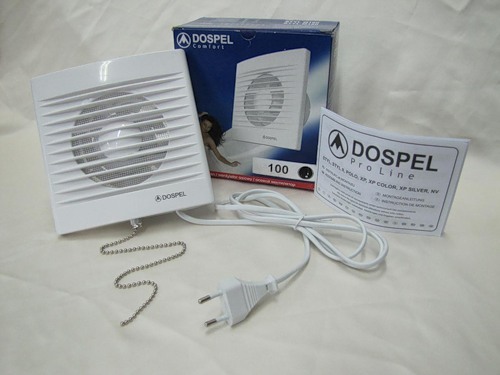
There are also models that are initially equipped with a plug for plugging into an outlet. They help out if the need for forced ventilation is identified after finishing finishing.
The advantages of such a connection include ventilation control from inside the bathroom - after all, according to the PUE any other switches and controls for electrical appliances must be located outside, in corridor.
Connecting the fan to the lighting
The simplest and most affordable option for arranging forced ventilation in a bathroom is to connect a fan to the nearest light bulb, spending a minimum of wires and efforts. In this case, the hood will work exactly as long as the light is on.
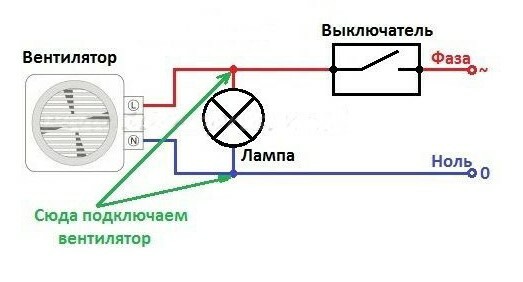
When connecting an exhaust fan in a bathroom or toilet according to this scheme, it is worth well insulating the wire connections
Installing a fan with three connection wires is a little more difficult. Such a unit requires constant power supply to the board, so both phase and zero are drawn to it directly from the box.
The switch opens the additional phase wire that controls the timer. All connections are described in more detail in the diagrams below.
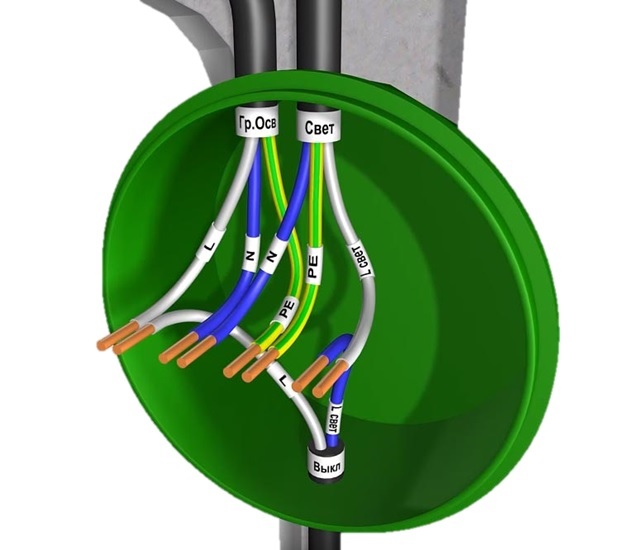
3 wires are already installed in the junction box: electricity supply from the panel (Gr. OSV), power supply of lighting in the bathroom (Light) and to the switch connected to the veins of the phase from the first two
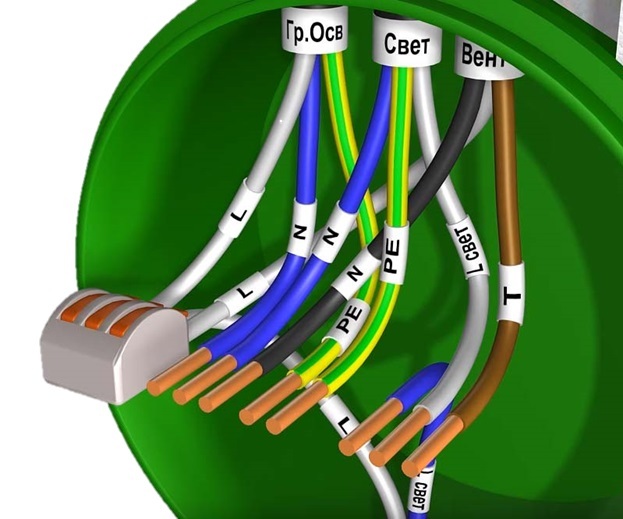
Of the three cores of the fan wire, one is closed directly to the phase coming from the panel - it will ensure the constant operation of the control board
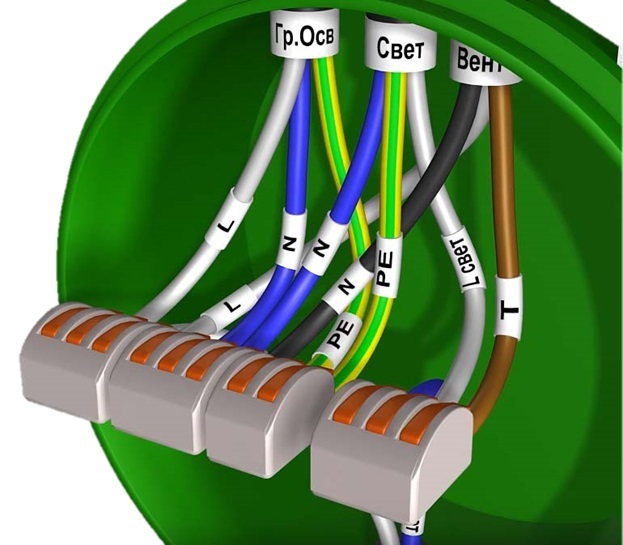
The zero core is connected to the rest of the zeros, and the third is connected to the wire coming from the switch - along with the phase supplying the lighting
Connecting through a box is safer, since all connections are outside the bathroom, but it has the same operating disadvantages as the connection with a light bulb. On the one hand, you will never forget to turn on the hood, you will need few wires, and you can hide them even after facing the walls - in the ceiling.
On the other hand, very few people will enjoy the draft and noise during bathing, and there may not be enough time to run on light for effective ventilation. As a result, you have to leave the lights on after leaving the bathroom or toilet, and this is an additional power consumption.
The presence of a built-in timer in the exhaust fan eliminates these disadvantages: in bath mode, it will turn on only after turning off the light and work for a specified time, and in the toilet will start up together with lighting.
Connection via switch
This connection scheme is the most versatile, reliable and widespread. It can be used to connect any fan model and control it manually, regardless of the lighting.
Connecting a fan with a timer is carried out in almost the same way as we described in the previous paragraph, about the connections in the junction box. The fundamental difference is that the phase conductor of the fan is not closed together with the lighting phase, but separately - to the separate conductors of the two-button switch.
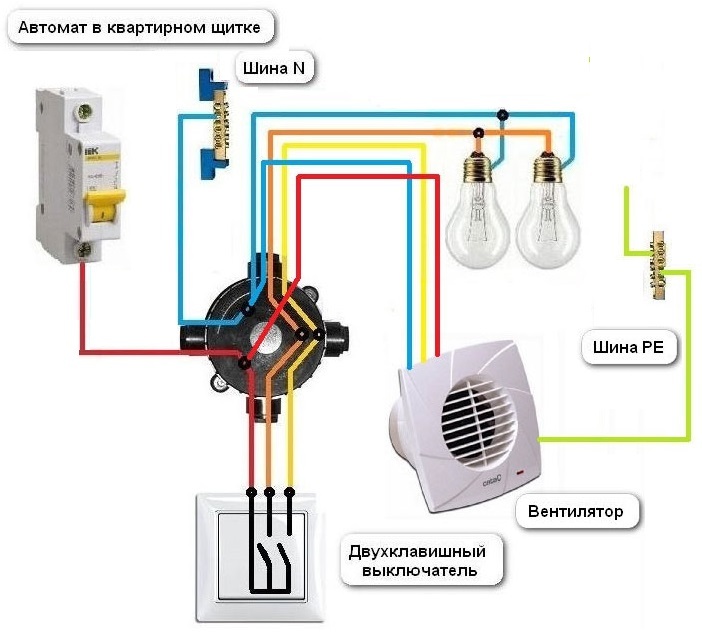
The wiring diagram for ventilation and lighting in the bathroom as a whole looks like this. Phase wires are marked in red, yellow and orange, blue - zero, light green - grounding, if provided in the fan
To connect in this way simple models without a built-in timer, it is enough to bring the zero wire directly from the junction box to the fan, and the phase from the switch. If a one-button light switch is already installed, it replace with a two-key, and the wire from it to the box is three-core. The phase wire is connected to the new core to power the fan.
Such a scheme can most often screw up for one reason: the phase and zero are mixed up.
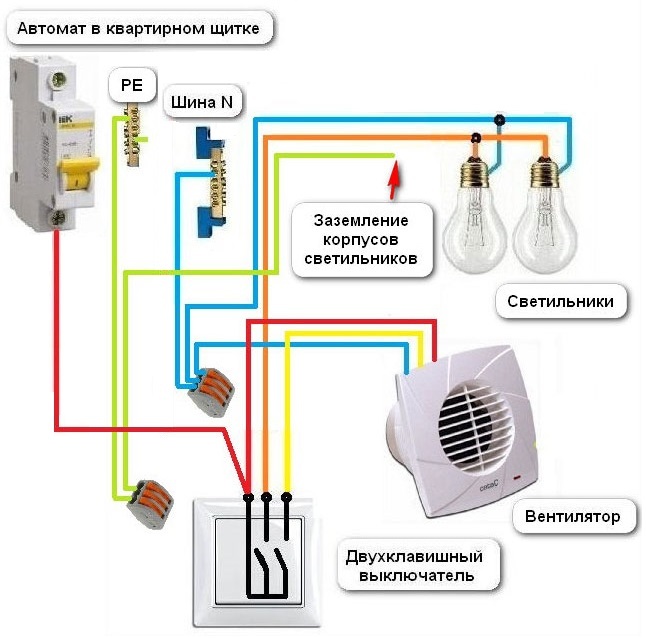
Alternatively, the connections can be made directly in the recessed socket - this will not affect the operation of the circuit.
If LED lights flash in the bathroom when the lights are off, and the electronically controlled fan behaves strangely Thus, it makes sense to open the junction box and once again double-check the presence of a phase on the wire leading to switch.
For more information on how to connect the fan to the switch, read Further.
Inclusion of an external sensor in the circuit
In any of the above schemes, you can include an additional sensor for humidity, air pollution, a timer (if there are no built-in ones), a motion or door opening sensor.
The most effective ventilation will be in the bathroom, controlled by a humidity sensor, and in the toilet - by a timer or air pollution sensor.

Additional sensors are connected to the phase wire - the same one that goes from the switch, into a single line. Sometimes you need a connection and zero to the device
It is worth noting that external sensors are usually much less durable and reliable in bathroom conditions than those built into the fan.
Fan installation procedure
As in any construction work, the ventilation system must first be designed. It is better to do this at the very beginning of the bathroom renovation in order to be able to hide all communications in the walls and under the ceiling.
If we are talking about a bathroom in an apartment where there is already a hole in the wall in the common ventilation duct, you just need to turn natural ventilation into forced ventilation. To do this, it is enough to decide on the fan model and the diagram of its connection to electricity.
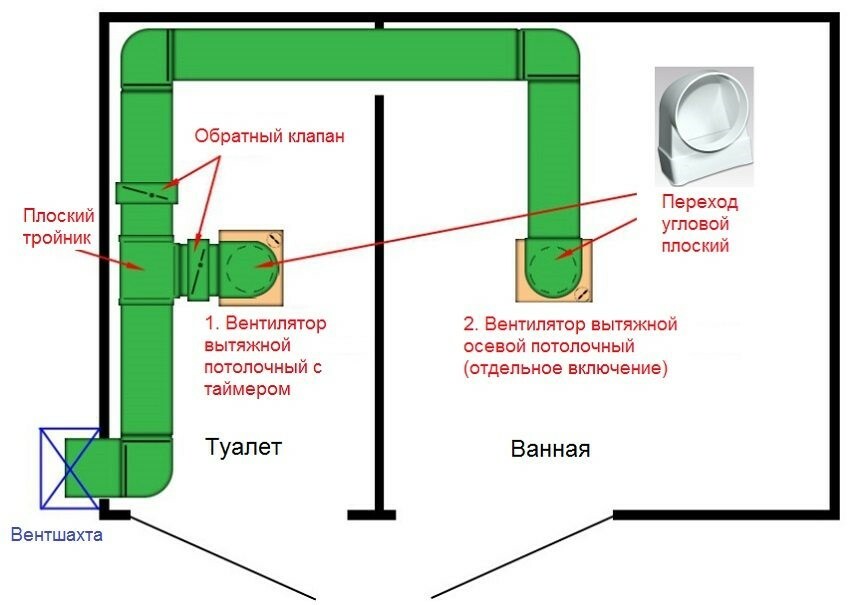
The exception is apartments in which the ventilation shaft adjoins only one of the premises of the separate bathroom - there will be a need for the construction of a canal.
In a private house, you usually have to build a system from scratch, bringing the ventilation pipe to the street through the roof, less often through the wall. In this case, it is necessary not only to think over everything, but also to draw up a plan diagram, according to which it will be convenient to read the necessary materials and carry out the installation.
It is worth checking the presence of natural draft in the existing mine, and in case of its complete absence, contact the housing office for cleaning. For effective air exchange, it is better to place the hood opposite the door or the flow valve, if there is one.
The next stage is the purchase of everything you need. It is even worth purchasing in advance what will be installed at the very end of the repair, because another fan model may not connect to the wires already connected.
Having figured out how to connect the purchased fan and choosing the ventilation scheme, you can start repairing the bathroom.
In the course of decorative finishing of walls and ceilings, wires are laid in corrugated insulating tubes, if necessary, a ventilation duct is built and the size of the hole for the fan is adjusted. Connection of wiring and installation of switches is also carried out at this stage.
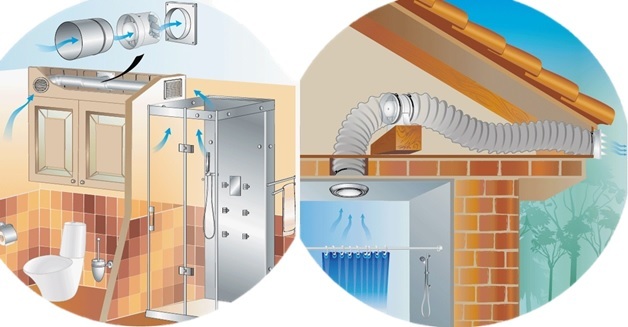
An alternative option, available only in a private house, is to install a duct fan. When installing it, only a special plate is screwed to the wall, and the main body with the motor snaps into the side fasteners
The fan itself is installed after finishing the finish. The installation procedure is as follows:
- Make sure that the wires leading out to the fan are de-energized.
- Remove the front panel, insert the housing into the hole and mark the mounting points on the tile with a marker.
- Drill holes with a drill with a drill for ceramics, hammer dowels into them. This step can be completely neglected or only part of the provided fasteners can be used. Plastic fans are lightweight, usually enough liquid nails or polymer glue to hold in place.
- Even when mounted on self-tapping screws, it is imperative to coat the perimeter of the fan case with silicone or other polymer - to absorb vibrations and prevent noise.
- Insert the body into the hole, check it against a level (for models with a square face) and press firmly until the sealant has set.
- Connect the wires to the terminals of the device and fix so that no exposed areas remain.
- Turn on ventilation, check the performance in all provided modes.
- Install the bezel.
This procedure is universal, suitable for overhead fans of any model. It also does not matter if the fan is installed in the wall or in the ceiling - only the installation is different channel models.
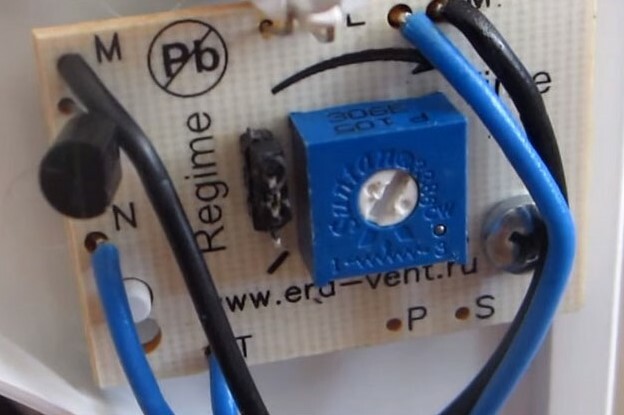
Some models have a control board with the ability to set the operating mode for a bathroom or toilet, as well as a timer
If the fan is designed with a timer, hygrometer, mode switch, or other equipment, remember to adjust it before you put on the decoration panel.
Often from the factory, the timer adjusting screw is unscrewed to a minimum - select the required duration of work experimentally.
There may also be a mode switch that looks like 3 or 4 metal pins with a removable jumper on two of them.
In the "toilet" mode, the fan starts immediately, simultaneously with the switching on of the light and the time set by the timer runs. In the "bathroom" mode, the start signal is to turn off the light, so that noise and drafts will not disturb you in the shower.
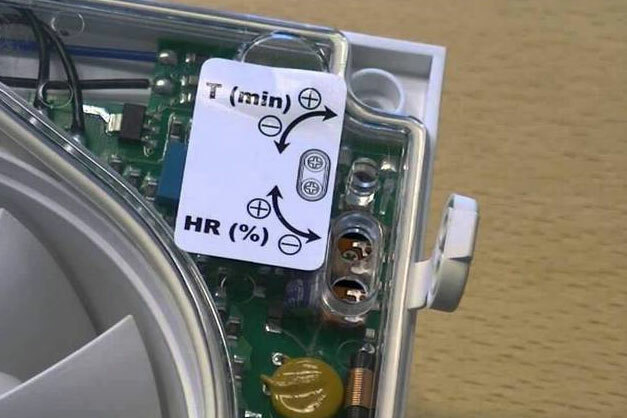
After adjusting and adjusting, do not forget to close the holes on the cover of the board against moisture, if it is provided for by the design.
The built-in hygrometer can be adjusted to a certain level of humidity at which the fan will start.
Common mistakes and additional tips
Fan connection errors can cause not only incorrect operation of the hood, but also a short circuit or fire. Do not forget that the bathroom is a room with high humidity, which means it is especially dangerous for electrical appliances and wiring.
In order to equip ventilation without errors on the first attempt, consider these tips:
- The fewer bends and the simpler the ventilation duct design, the better the draft.
- With a single ventilation system of a separate bathroom, air must move from the bath to the toilet, and not vice versa.
- For all wire connections, use terminal blocks, not duct tape.
- Strip exactly that part of the wire that goes into the terminal block.
- Check for a mosquito net in the fan. If suddenly it is not there - add, because mosquitoes and other insects feel great in warm, humid ventilation shafts.
- In a private house, be sure to insulate part of the ventilation duct or shaft passing through unheated rooms. Otherwise, there will be no thrust in cold weather.
- Do not neglect grounding for metal fans.
In addition, so that the fan does not interfere with natural ventilation when it is turned off, you can use double rectangular grilles, with a fan hole at the top and a regular grill below it.

When connecting the fan power supply, do not mix up the contacts: N - zero, T or LT - timer, phase from the switch, L or Line - phase directly from the box
If it is not possible to install a double grille, you can preserve natural ventilation by substituting 1 - 2 cm foam legs under the corners of the case, in the attachment points with self-tapping screws. As a rule, the ventilation window is square, and the fan housing is round, and these gaps are sufficient for air circulation.
Please note that even a perfectly installed and powerful enough fan will not work efficiently if there is not enough ventilation. Usually it is provided by a gap of 1.5–2 cm under the door to the bathroom, but for beauty it can be replaced with a special lattice that cuts into the lower part of the door.
Also, make sure that fresh air enters the house at all, because after installing plastic windows and new doors, wall insulation and concrete screed on the floor, the apartment turns out to be hermetically sealed, like a thermos.
In addition, the exhaust fan may need cleaning. Therefore, we recommend that you also read the step-by-step instructions for disassembling and cleaning the device. More details - go to link.
Conclusions and useful video on the topic
The construction of a ventilation duct for autonomous ventilation of the toilet and bathroom in the presence of only one shaft is clearly shown in this video:
The connection of a simple fan is described in detail here:
Summing up, we can say that it is quite possible to independently equip an effective ventilation system in an apartment, but you need to be careful and think carefully about everything in advance. If you are not confident in your abilities, entrust the case to a specialist, because mistakes in working with electrical wiring can lead to sad consequences.
Have you ever installed a fan in your bathroom or toilet? Please tell us which connection scheme did you use and were there any difficulties in installation? Leave your comments, share your experience - the communication block is located under the article.


